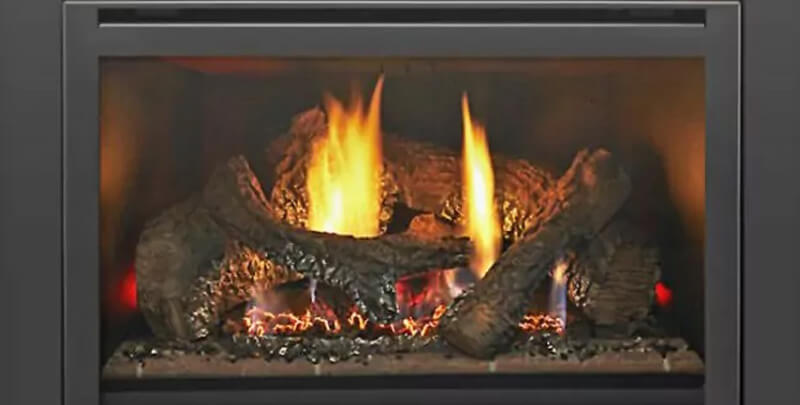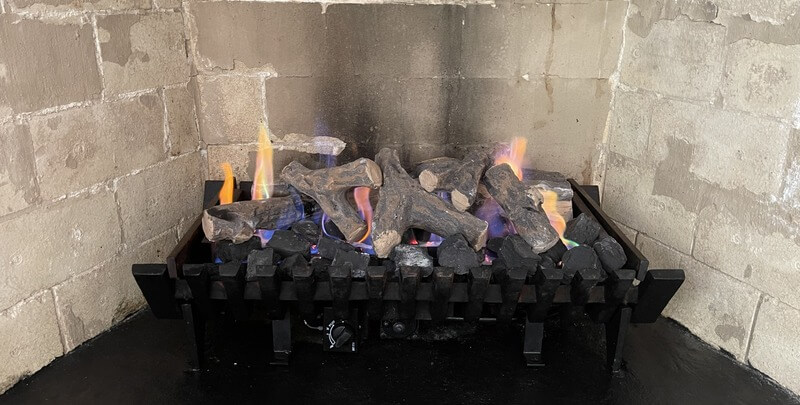Are Gas Log Fires Expensive to Run?

When it comes to gas fireplaces for the home, gas log fires have become a popular heating choice. They offer the aesthetic appeal and practical warmth of traditional wood burning fireplaces, without the hassle of collecting firewood, storing it and cleaning up the ashes. That being said, potential buyers often wonder about the running costs associated with these systems.
Understanding whether gas log fires are expensive to run is crucial for making an informed decision. This article aims to provide general information on the costs involved, from initial installation to ongoing operational costs, and compare them with other heating options. By the end, you’ll have a clearer picture of whether you want a gas fireplace installed in your living environment.
What are Gas Log Fires?
Gas log fires are a modern heating solution designed to mimic the look of traditional wood-burning fireplaces. They use ceramic or refractory logs that are intricately designed to resemble real wood. A gas log fireplace ultimately provides a cosy and authentic fireplace experience without the hassle of actually burning real wood.
These gas fireplaces run on natural gas directly from your gas line, or liquefied petroleum gas (LPG). They come with either a switch or remote control operation. Unlike a traditional wood-burning fireplace, a gas log fireplace offers the convenience of instant heat and adjustable heat settings.
Gas log fires come in various styles and sizes to suit different home décors and heating needs. From built-in units to freestanding models, they provide a straightforward installation process and allow for flexible placement. Additionally, their clean-burning nature means less maintenance and no ash or soot to clean up.

The Purchase and Installation Costs for Gas Fireplaces
The initial costs of purchasing a gas log fireplace can vary significantly depending on your chosen model and brand. These prices can depend on:
- the design
- materials
- additional features such as remote control and variable heat settings
Installation costs are another important factor to consider. Professional installation by a licensed gas fitter is essential for safety and efficiency. The complexity of the installation, such as connecting to existing gas lines or creating new ones, can influence the overall price. You’ll likely also want a carbon monoxide detector installed at the same time, as this will pick up on any traces of the potentially lethal gas combustion by-products. Carbon monoxide is otherwise colourless and odourless, so is rarely if ever identifiable by the human senses.
Running Costs
The running costs of gas log fires depend on several factors, including:
- the type of gas used
- the efficiency of the unit
- gas consumption rate
- daily usage patterns
Natural gas is typically cheaper than LPG, but the overall cost can vary based on local gas prices and your provider’s gas rate.
Efficiency plays a crucial role in determining accurate running costs. High-efficiency models convert more gas into heat, reducing wasted energy and lowering your gas bill. Units with efficiency ratings above 70% are generally more cost-effective to run. It’s advisable to check the power rating label when running a gas log fireplace to estimate potential savings.
Usage patterns also impact running costs. Regular use during winter months will naturally increase expenses. However, setting your gas log fire to a moderate temperature and using it alongside other heating methods can help manage costs.
Energy Efficiency
Energy efficiency is a key factor in the running costs of gas log fires. Features like programmable thermostats, electronic ignition, and modulating gas valves can help optimise performance and reduce daily energy consumption. These advanced features ensure that the unit operates only when needed and maintains a consistent temperature.
Regular maintenance of your gas log fire is essential to maximising its efficiency and high heating capacity. Keeping the unit clean and ensuring that all components are functioning correctly can prevent gas fireplaces from losing nearly all their energy. Additionally, using your gas log fire in conjunction with other heating methods, such as ceiling fans (operating in reverse) or insulation, can enhance overall energy efficiency and contribute to a more comfortable and cost-effective home environment.
Environmental Impact
The environmental impact of a gas log fireplace is an important consideration for eco-conscious homeowners. Unlike a wood fireplace which will emit pollutants directly into the indoor or outdoor air, a gas fireplace will minimise local air pollution and greenhouse gases. The combustion process in gas log fires emits lower levels of carbon dioxide and virtually no particulate matter, contributing to better indoor air quality.
Natural gas is a fossil fuel, but it burns more cleanly compared to coal or oil. Choosing a high-efficiency gas log fireplace further reduces environmental impact by minimising wasted energy and lowering daily gas consumption. Opting for a natural gas supply over LPG can also decrease emissions due to its cleaner-burning properties.

So, How Do Gas Fireplaces Stack Up Against Electric Fireplaces?
Let’s take a moment to compare gas and electric fireplaces to determine how they stack up against each other.
Compared to modern gas fireplaces, electric fireplaces generally have lower installation costs. However, electric fireplaces require a power point so you’ll either need to install it next to an established power point or have an electrician install a new one.
Unlike gas fireplaces, electric fireplaces operate without combustion. This means that you don’t have to worry about the possibility of a carbon monoxide leak or installing venting systems.
All in all, electric fireplaces offer a worthy alternative for homes that may not have access to a running gas connection. They require little maintenance, are highly convenient and are an effective means of reducing local air pollution. Of course, rising electricity prices may be the deciding factor in whether an electric or gas fireplace is right for your home.
Is an Gas Log Fireplace the Right Choice for Your Home?
Gas log fires offer a blend of aesthetic appeal, convenience, and efficiency. While the initial costs and installation fees may be higher compared to other heating options, like an electric fireplace, the lower running costs and minimal maintenance make them a practical choice for many Australian homes.
Considering factors such as high energy efficiency and environmental impact, gas log fires present a relatively eco-friendly heating solution. By weighing the initial investment against the long-term benefits and savings, homeowners can make an informed decision about whether a new fireplace is the right fit for their needs and lifestyle.
Please note: Thank you for reading our blog “Are Gas Log Fires Expensive To Run?”. This information is provided for advice purposes only. Regulations differ from state to state, so please consult your local authorities or an industry professional before proceeding with any work. See After Hours Air Conditioning’s Terms & Conditions here.